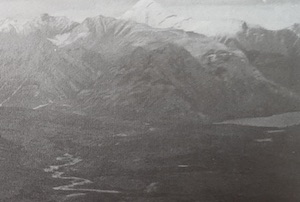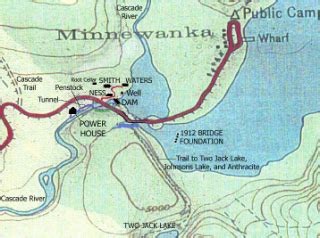I went looking for the Anthracite mine today. From Johnson Lake a foot path heads down by the river toward the highway. Across the river I noticed what looked like a mine entrance shrouded in thick moss. Scattered nearby were lumps of coal and jumbled rocks. Another possible entrance was lower down but it may have been too small to be one. I headed down the river and encountered a sign stating, "Reserved for wildlife. We ask for co-operation in not entering theis environmentally sensitive area. The Fairholme Benchlands is important habitat for wildlife. It is the last remaining block of undeveloped mixed forest and grasslands in the Bow Valley."
I'm never sure what to do when I see a sign like that. There was an animal path leading East, so I carefully followed it for a short distance only to notice a pipeline surface out of the ground to accompany me. Further ahead I noticed three long piles of... coal? Yes, slack heaps--coal that wasn't marketable was piled up here 100+ years ago and left to become part of the landscape. Two piles had small trees growing in them, but the middle pile was bare--a toxic pile of coal that will probably remain bare for another few hundred years. Up the cliffs Johnson Lake is dammed, making me wonder how much smaller it was before the 1880's. And the path around Johnson lake is made of waste coal, most likely an inexpensive way of creating a path that doesn't grow anything. I made me wonder how the sign could say, "undeveloped mixed forest."
The actual town of Anthracite was demolished when the Trans Canada highway was put through, with very few remains. I went searching for some remains east of town, south of Cascade river below the sandstone cliffs and found what looked like a foundation and 4 inch pipe which could have been for sewer. There's also a sign nearby asking people not to disturb the area because it may have been a burial ground. I tried to head toward the main town site, but I would have to cross the Cascade river, which was pretty wide there.
I took a few pictures on the Polaroid, folded up the tripod and noticed my hands were dirty from coal tar. I walked slowly back to Johnson Lake, trying to imagine what it was like 120 years ago, when 300 people lived here mining coal. Looking around, I couldn't be sure what is natural and what had been altered by mining. I realized this isn't what Banff was, but this is Banff now.
Go to Anthracite

